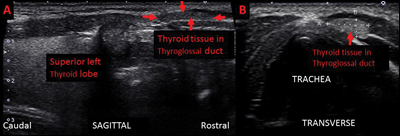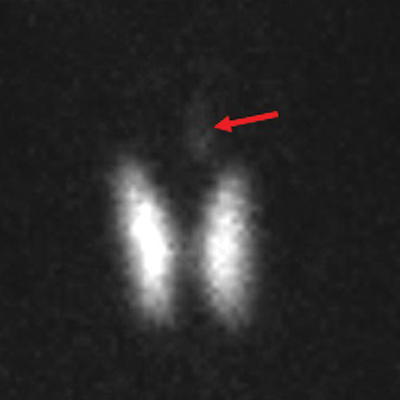Incidental detection of ectopic thyroid tissue


A 46-year-old Asian woman was seen in the endocrine clinic for evaluation of a goiter. She was originally from China, where here physician noted that she had an enlarged thyroid gland and reported an abnormal thyroid by ultrasound.
She had no symptoms of neck enlargement, dysphagia, voice changes, compressive symptoms, history of head or neck radiation or thyroid hormone dysfunction. Her family history was notable for mother and a brother with a history of enlarged thyroid glands requiring thyroidectomy without additional details, but there was no known family history of thyroid cancer.

Laboratory tests, imaging
Her thyroid gland was palpable with slightly firm texture, but no discrete nodules. There was no cervical lymphadenopathy present on exam. Thyroid function testing revealed a normal thyroid-stimulating hormone level of 0.8 µIU/mL (normal range, 0.35- 4.9 µIU/mL) and normal free thyroxine index of 1.3 (normal range, 1-4) without evidence of autoimmune thyroid disease by thyroid peroxidase antibody levels.
A thyroid ultrasound was performed showing a mildly enlarged gland in the thyroid bed with a very mildly heterogeneous echotexture and few subcentimeter cysts in the lateral and mid-left lobe (Figure 1). In addition, there was a focus of homogenous tissue superior to and separate from the thyroid isthmus just inferior to the hyoid bone measuring 1 cm x 0.3 cm x 0.7 cm (Figure 2). This tissue was located approximately 2 cm rostral to the thyroid without discrete nodules, microcalcifications or hypervascularity with the same echogenicity of the thyroid gland, suggesting the presence of ectopic thyroid tissue.

On exam, this mass was a 1-cm firm, mobile area of tissue slightly left of and inferior to the hyoid bone. A nuclear medicine iodine-123 thyroid uptake and scan confirmed a normal-functioning thyroid gland in the thyroid bed and the presence of functional thyroid tissue in the region of the thyroglossal duct tract superior to the thyroid without evidence of photopenic defects or hyperfunctioning foci (Figure 3). These studies confirmed that the mass was ectopic thyroid tissue in the thyroglossal duct remnant.
Ectopic tissue
Ectopic thyroid tissue results from a defect in the fetal migration of thyroid tissue from the foramen cecum in the posterior tongue through the thyroglossal duct to its final position in the thyroid bed. It is more commonly seen in females with a female-to-male ratio of 4:1 and has been described in all ages with reported clinical incidence varying between 1 in 3,000 and 1 in 10,000.
About 90% of ectopic thyroid tissue is located in the foramen cecum at the base of the tongue, known as lingual thyroid, and can be associated with symptoms related to mass effect, including foreign-body sensation, cough, dysphagia, breathing obstruction or hemorrhage. Less often, ectopic thyroid tissue may be found between the base of the tongue and its final position in the anterior neck and more rarely can be seen in the mediastinum. The presence of more than one foci of ectopic tissue has also been described, often consisting of coexisting lingual and sublingual thyroid tissue.

Images courtesy of Stephanie L. Lee, MD, PhD, ECNU; and Catherine Sullivan, MD, reprinted with permission.
Sublingual ectopic thyroid may be asymptomatic or present with a painless, mobile mass. It is important to recognize that ectopic thyroid tissue may be the only functioning thyroid tissue present, and removal due to mass effect or concern for malignancy could result in hypothyroidism, even when there is tissue present in the thyroid bed.
Diagnosis, management
The differential diagnosis for a midline neck mass includes fibromas, lymphangiomas, small salivary gland tumors, thyroglossal duct cysts, midline branchial cyst and epidermal inclusion cysts. Imaging is useful in the evaluation of an anterior neck mass and can help support the presence of more benign conditions. A standard part of a thyroid ultrasound should include a rostral examination in the midline for a pyramidal lobe or thyroglossal duct. On ultrasound, ectopic thyroid tissue should have a similar echogenicity to the thyroid gland, if this is present.
The presence of suspicious-appearing thyroid nodules or abnormal level II-VI lymph nodes should raise awareness of the possibility that ectopic tissue may represent metastatic thyroid carcinoma. The risk for cancer (5% to 10%) in a thyroglossal duct nodule is the same as for a thyroid nodule.
A thyroid scan with I-123 is useful to confirm the presence of functional thyroid tissue and to further distinguish ectopic thyroid from other midline structures. Contrast-enhanced CT scan may additionally be required to distinguish ectopic thyroid tissue from other structures and can be useful for surgical planning.
Management of ectopic thyroid tissue is dependent on the presence of localized symptoms and concern for malignancy. If needed, surgery can be performed as first-line treatment, with radioactive iodine or suppressive levothyroxine therapy used as second-line options. If radioactive iodine is employed, often higher doses are required due to decreased uptake at ectopic thyroid locations.
The ectopic thyroid tissue in this patient does not contain a nodule and is asymptomatic. Surgery is not necessary, and watchful waiting will be employed by repeat ultrasound exams.
- References:
- Baskin HJ, et al. Thyroid Ultrasound and Ultrasound-Guided FNA. 3rd ed. New York, NY: Springer; 2013.
- Noussios G, et al. Eur J Endocrinol. 2011;doi:10.1530/EJE-11-0461.
- Oomen KP, et al. Otolaryngol Clin North Am. 2015;doi:10.1016/j.otc.2014.09.003.
- For more information:
- Stephanie L. Lee, MD, PhD, ECNU, is an Endocrine Today Editorial Board member. She is associate professor of medicine and director of thyroid health in the Section of Endocrinology, Diabetes and Nutrition at Boston Medical Center. She can be reached at Boston Medical Center, 88 E. Newton St., Boston, MA 02118; email: stephanie.lee@bmc.org.
- Catherine Sullivan, MD, is a fellow, Section of Endocrinology, Diabetes and Nutrition at Boston Medical Center. She can be reached at Boston Medical Center, 88 E. Newton St., Boston, MA 02118.
Disclosure: Lee and Sullivan report no relevant financial disclosures.
